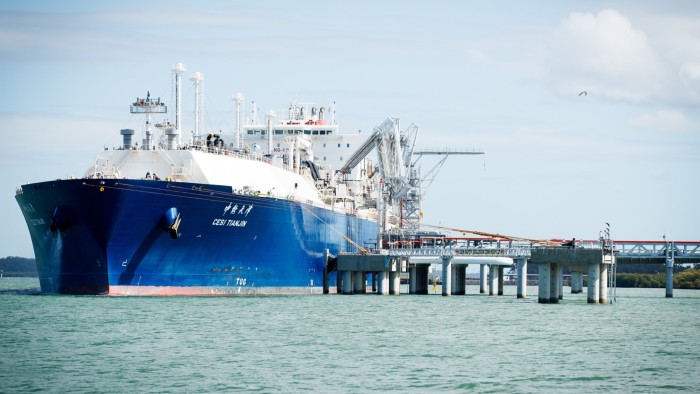Unlock the Editor’s Digest for free
Roula Khalaf, Editor of the FT, selects her favourite stories in this weekly newsletter.
Global demand for liquefied natural gas is forecast to surge 60 per cent by 2040 due to faster economic growth in Asia and the race to decarbonise industry, Shell has said.
The energy major’s widely followed annual outlook on the super-chilled fuel is 10 percentage points higher than what was predicted last year for the same period, reflecting stronger demand from India and China.
“The global trade in LNG is set to rise significantly by 2040, driven by Asian economic growth, the need to decarbonise heavy industry and transport and the emerging growth in the energy-intense tech sector,” the company said.
Shell is the world’s biggest LNG trader, shifting about 60mn tonnes of the fuel every year. It compiles the outlook by interpreting data from several energy consultants, such as Wood Mackenzie and S&P Global Commodity Insights.
China, the world’s largest LNG importer, was “significantly increasing” its import capacity to provide piped gas connections for 150mn people by 2030, while India was improving its infrastructure to connect 30mn people over the next five years, Shell said.
LNG, natural gas that is liquefied by cooling it to minus 162C, has become increasingly important since Russia invaded Ukraine in 2022. Europe has become a big importer as it sought to replace reduced flows of Russian pipeline gas, putting the region in competition with Asian countries to secure limited shipments.
Shell said Europe would “continue to need LNG into the 2030s to balance the growing share of intermittent renewables in its power sector and to ensure energy security” as it moves towards net zero.
Gas provided a “crucial back-up” when there was lower renewables generation and was more economical to use than batteries, said Cederic Cremers, executive vice-president for LNG at Shell.
“That’s why industry analysts expect demand for LNG will continue to grow modestly in Europe through to the 2030s,” he added.
European countries, especially Germany, had invested heavily in LNG import infrastructures during the energy crisis sparked by the war in Ukraine, and those assets “could be used to import bio-LNG or synthetic LNG and be repurposed for the import of green hydrogen”, Shell said.
Shell and its competitors are keen to position natural gas and LNG as a cleaner alternative to coal and a transition fuel for the world to decarbonise, despite natural gas releasing substantial amounts of carbon dioxide when burnt.
It is also mostly composed of methane, which generates more warming than carbon dioxide, and LNG trading has also been criticised for its emissions footprint.
Global demand in LNG would increase to between 630mn and 718mn tonnes by 2040, from 407mn tonnes last year, Shell said. Last year’s outlook pegged the demand at between 625mn and 685mn tonnes. More than 170mn tonnes of new LNG supply was expected to come online by 2030 to meet the rising demand, the company added.
A significant volume of the new supply was set to come from the US, but further growth in the country came “with risks” such as regulatory uncertainty and construction costs, it said.
https://www.ft.com/content/40b73699-236d-430c-b329-8121ff6d356e


